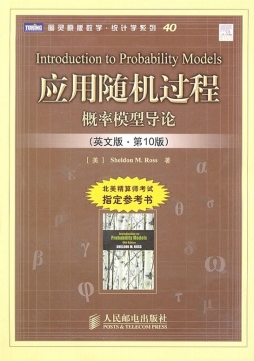应用随机过程——概率模型导论
出版社:人民邮电出版社
年代:2010
定价:99.0
书籍简介:
本书主要内容有随机变量、条件概率及条件期望、离散及连续马尔可夫链、指数分布、泊松过程、布朗运动及平稳过程、更新理论及排队论等;也包括了随机过程在各领域中的应用.本书有约700道习题,其中带星号的习题还提供了解答.
作者介绍:
书籍目录:
1 introduction to probability theory
1.1 introduction
1.2 sample space and events
1.3 probabilities defined on events
1.4 conditional probabilities
1.5 independent events
1.6 bayes' formula
exercises
references
2 random variables
2.1 random variables
2.2 discrete random variables
2.2.1 the bernoulli random variable
2.2.2 the binomial random variable
2.2.3 the geometric random variable
2.2.4 the poisson random variable
2.3 continuous random variables
2.3.1 the uniform random variable
2.3.2 exponential random variables
2.3.3 gamma random variables
2.3.4 normal random variables
2.4 expectation of a random variable
2.4.1 the discrete case
2.4.2 the continuous case
2.4.3 expectation of a function of a random variable
2.5 jointly distributed random variables
2.5.1 joint distribution functions
2.5.2 independent random variables
2.5.3 covariance and variance of sums of random variables
2.5.4 joint probability distribution of functions of randomvariables
2.6 moment generating functions
2.6.1 the joint distribution of the sample mean and sample variance from a normal population
2.7 the distribution of the number of events that occur
2.8 limit theorems
2.9 stochastic processes
exercises
references
3 conditional probability and conditional expectation
3.1 introduction
3.2 the discrete case
3.3 the continuous case
3.4 computing expectations by conditioning
3.4.1 computing variances by conditioning
3.5 computing probabilities by conditioning
3.6 some applications
3.6.1 a list model
3.6.2 a random graph
3.6.3 uniform priors, polya's urn model, and bose-einstein statistics
3.6.4 mean time for patterns
3.6.5 the k-record values of discrete random variables
3.6.6 left skip free random walks
3.7 an identity for compound random variables
3.7.1 poisson compounding distribution
3.7.2 binomial compounding distribution
3.7.3 a compounding distribution related to the negative binomial
exercises
4 markov chains
4.1 introduction
4.2 chapman-kolmogorov equations
4.3 classification of states
4.4 limiting probabilities
4.5 some applications
4.5.1 the gambler's ruin problem
4.5.2 a model for algorithmic efficiency
4.5.3 using a random walk to analyze a probabilistic algorithm for the satisfiability problem
4.6 mean time spent in transient states
4.7 branching processes
4.8 time reversible markov chains
4.9 markov chain monte carlo methods
4.10 markov decision processes
4.11 hidden markov chains
4.11.1 predicting the states
exercises
references
5 the exponential distribution and the poisson process
5.1 introduction
5.2 the exponential distribution
5.2.1 definition
5.2.2 properties of the exponential distribution
5.2.3 further properties of the exponential distribution
5.2.4 convolutions of exponential random variables
5.3 the poisson process
5.3.1 counting processes
5.3.2 definition of the poisson process
5.3.3 interarrival and waiting time distributions
5.3.4 further properties of poisson processes
5.3.5 conditional distribution of the arrival times
5.3.6 estimating software reliability
5.4 generalizations of the poisson process
5.4.1 nonhomogeneous poisson process
5.4.2 compound poisson process
5.4.3 conditional or mixed poisson processes
exercises
references
6 continuous-time markov chains
6.1 introduction
6.2 continuous-time markov chains
6.3 birth and death processes
6.4 the transition probability function pij (t)
6.5 limiting probabilities
6.6 time reversibility
6.7 uniformization
6.8 computing the transition probabilities
exercises
references
7 renewal theory and its applications
7.1 introduction
7.2 distribution of n(t)
7.3 limit theorems and their applications
7.4 renewal reward processes
7.5 regenerative processes
7.5.1 alternating renewal processes
7.6 semi-markov processes
7.7 the inspection paradox
7.8 computing the renewal function
7.9 applications to patterns
7.9.1 patterns of discrete random variables
7.9.2 the expected time to a maximal run of distinct values
7.9.3 increasing runs of continuous random variables
7.10 the insurance ruin problem
exercises
references
8 queueing theory
8.1 introduction
8.2 preliminaries
8.2.1 cost equations
8.2.2 steady-state probabilities
8.3 exponential models
8.3.1 a single-server exponential queueing system
8.3.2 a single-server exponential queueing system having finite capacity
8.3.3 birth and death queueing models
8.3.4 a shoe shine shop
8.3.5 a queueing system with bulk service
8.4 network of queues
8.4.1 open systems
8.4.2 closed systems
8.5 the system m/g/1
8.5.1 preliminaries: work and another cost identity
8.5.2 application of work to m/g/1
8.5.3 busy periods
8.6 variations on the m/g/1
8.6.1 the m/g/1 with random-sized batch arrivals
8.6.2 priority queues
8.6.3 an m/g/1 optimization example
8.6.4 the m/g/1 queue with server breakdown
8.7 the model g/m/1
8.7.1 the g/m/1 busy and idle periods
8.8 a finite source model
8.9 multiserver queues
8.9.1 erlang's loss system
8.9.2 the m/m/k queue
8.9.3 the g/m/k queue
8.9.4 the m/g/k queue
exercises
references
9 reliability theory
9.1 introduction
9.2 structure functions
9.2.1 minimal path and minimal cut sets
9.3 reliability of systems of independent components
9.4 bounds on the reliability function
9.4.1 method of inclusion and exclusion
9.4.2 second method for obtaining bounds on r(p)
9.5 system life as a function of component lives
9.6 expected system lifetime
9.6.1 an upper bound on the expected life of a parallel system
9.7 systems with repair
9.7.1 a series model with suspended animation
exercises
references
10 brownian motion and stationary processes
10.1 brownian motion
10.2 hitting times, maximum variable, and the gambler's ruin problem
10.3 variations on brownian motion
10.3.1 brownian motion with drift
10.3.2 geometric brownian motion
10.4 pricing stock options
10.4.1 an example in options pricing
10.4.2 the arbitrage theorem
10.4.3 the black-scholes option pricing formula
10.5 white noise
10.6 gaussian processes
10.7 stationary and weakly stationary processes
10.8 harmonic analysis of weakly stationary processes
exercises
references
11 simulation
11.1 introduction
11.2 general techniques for simulating continuous random variables
11.2.1 the inverse transformation method
11.2.2 the rejection method
11.2.3 the hazard rate method
11.3 special techniques for simulating continuous random variables
11.3.1 the normal distribution
11.3.2 the gamma distribution
11.3.3 the chi-squared distribution
11.3.4 the beta (n, m) distribution
11.3.5 the exponential distribution-the von neumann algorithm
11.4 simulating from discrete distributions
11.4.1 the alias method
11.5 stochastic processes
11.5.1 simulating a nonhomogeneous poisson process
11.5.2 simulating a two-dimensional poisson process
11.6 variance reduction techniques
11.6.1 use of antithetic variables
11.6.2 variance reduction by conditioning
11.6.3 control variates
11.6.4 importance sampling
11.7 determining the number of runs
11.8 generating from the stationary distribution of a markov chain
11.8.1 coupling from the past
11.8.2 another approach
exercises
references
appendix: solutions to starred exercises
index
内容摘要:
《应用随机过程:概率模型导论(英文版·第10版)》叙述深入浅出,涉及面广。主要内容有随机变量、条件概率及条件期望、离散及连续马尔可夫链、指数分布、泊松过程、布朗运动及平稳过程、更新理论及排队论等;也包括了随机过程在物理、生物、运筹、网络、遗传、经济、保险、金融及可靠性中的应用。特别是有关随机模拟的内容,给随机系统运行的模拟计算提供了有力的工具。除正文外,《应用随机过程:概率模型导论(英文版·第10版)》有约700道习题,其中带星号的习题还提供了解答。
《应用随机过程:概率模型导论(英文版·第10版)》可作为概率论与统计、计算机科学、保险学、物理学、社会科学、生命科学、管理科学与工程学等专业的随机过程基础课教材。
编辑推荐:
《应用随机过程:概率模型导论(英文版·第10版)》是国际知名统计学家Sheldon M,Ross所著的关于基础概率理论和随机过程的经典教材。被加州大学伯克利分校,哥伦比亚大学、普度大学、密歇根大学、俄勒冈州立大学,华盛顿大学等众多国外知名大学所采用。
与其他随机过程教材相比。《应用随机过程:概率模型导论(英文版·第10版)》非常强调实践性。内含极其丰富的例子和习题,涵盖了众多学科的各种应用。作者富于启发而又不失严密性的叙述方式,有助于使读者建立概率思维方式,培养对概率理论、随机过程的直观感觉。对那些需要将概率理论应用于精算学,运筹学,物理学,工程学,计算机科学。管理学和社会科学的读者而言,《应用随机过程:概率模型导论(英文版·第10版)》是一本极好的教材或参考书。
《应用随机过程:概率模型导论(英文版·第10版)》特色
秉承作者招牌式的深入浅出,娓娓道来的写作风格。
增加了关于不带左跳的随机徘徊、生灭排队模型、马尔可夫链和保险破产模型等方面的重要内容。
增加了新的例子和习题,更加注重强化读者的概率直观。
